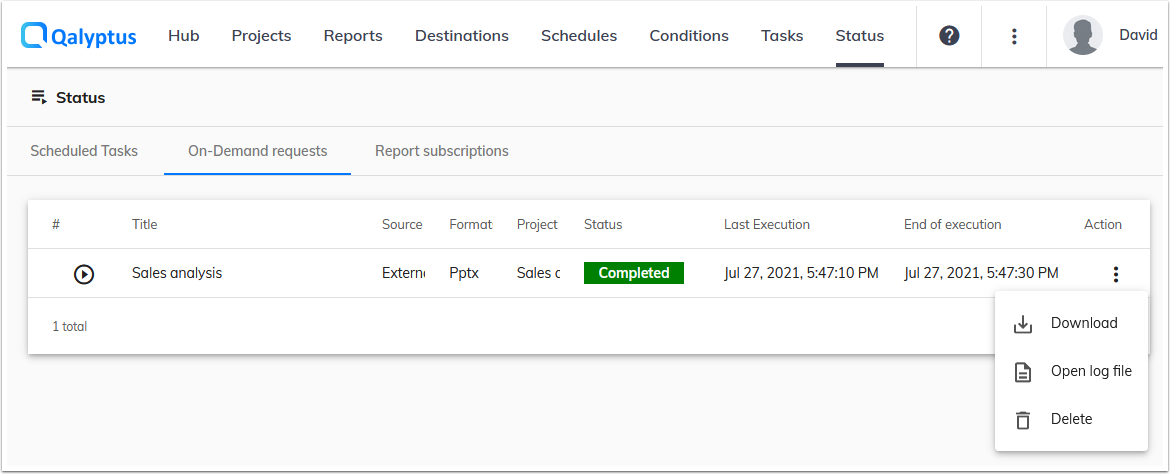Qalyptus On-Demand
Using the Qlik Sense extension Qalyptus On-Demand, you can generate your reports created with Qalyptus directly from a Qlik Sense application.
Qalyptus use the Qlik Sense user profile to generate the report. In other words, Qalyptus will consider the existing Section Access in the application when generating the report. If, for example, the user only has access to his department's data, when generating the report, only the data of his department will be visible on the report.
Note that you must add the domain account (DOMAIN\username) of the user in their information.
Qalyptus On-Demand Overview
Configure Qalyptus On-Demand
Qalyptus On-Demand needs Qalyptus Server to generate the reports. Before using Qalyptus On-Demand, you need to install and configure Qalyptus Server. Se how to install Qalyptus Server.
Where can I find the Qalyptus On-Demand extension? After installing Qalyptus Server you will find Qalyptus On-Demand in the folder: C:\ProgramData\Qalyptus\Extensions
1- Allow using Qalyptus On-Demand
Qalyptus On-Demand is a Qlik Sense extension that uses the Qalyptus API to communicate with Qalyptus Server. For security reasons, you must add the Qlik Sense address as a trusted origin, choose the users who will be allowed to use Qalyptus On-Demand, and choose which reports you want to be visible to users on Qalyptus On-Demand.
1-1 Add Qlik Sense address as a trusted origin
Every time you want to communicate with Qalyptus Server from another web application, you need to add the address of this application in the list of the trusted origins.
To add the Qlik Sense address as a trusted origin in Qalyptus Server, do the following:
- Connect to Qalyptus Server
- Go Qalyptus Administration> System> Trusted Origins
- Click Add Origin
- Enter a name for the origin
- Enter a description (optional)
- Enter the address of your Qlik Sense. Example: https://qlik-sense-url.com
- Click Save
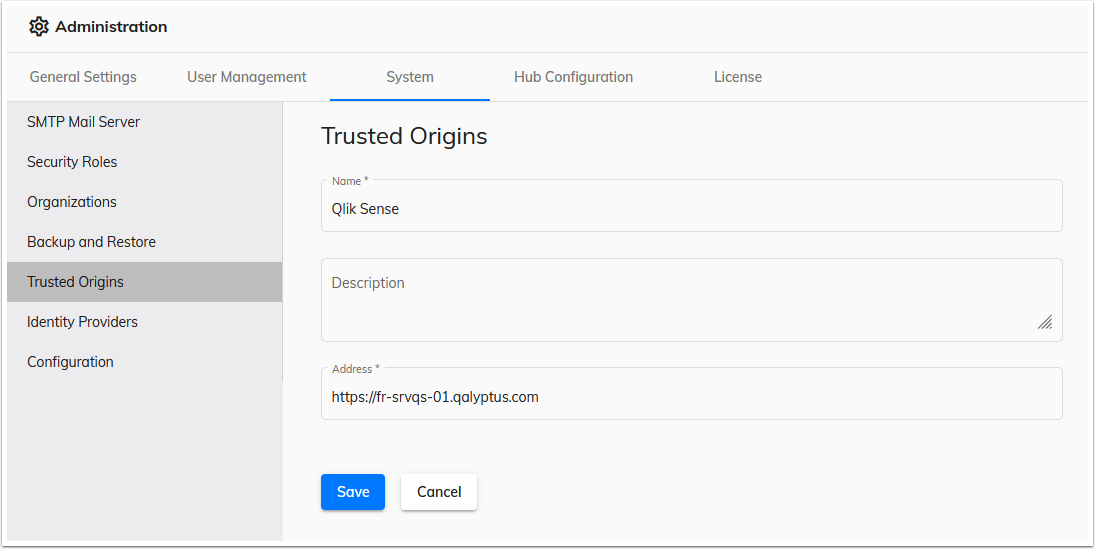
1-2 Attribute permissions to the users
For users who you want to allow to use Qalyptus On-Demand, you need to attribute them a Role that contains the permission “Use API, Qalyptus On-Demand and Qalyptus Self-Reporting.”
For more details on creating and attributing a role to users, see the section: Security Roles.

1-3 Make reports available for Qalyptus On-Demand
By default, reports are not visible in Qalyptus On-Demand. For each report, you need to choose the users that can view it and generate it in Qalyptus On-demand.
To choose the users that can view and generate a report in Qalyptus On-Demand, do the following:
- Connect to Qalyptus Server
- Go to the Reports page
- Edit the report you want to make visible for the users. Example: Sales analysis
- Select the tab API and On-Demand report restrictions
- Click Add Users or Add Groups
- Add users and/or groups. If you want to allow all users, choose the default group “All users.”
- Click Save
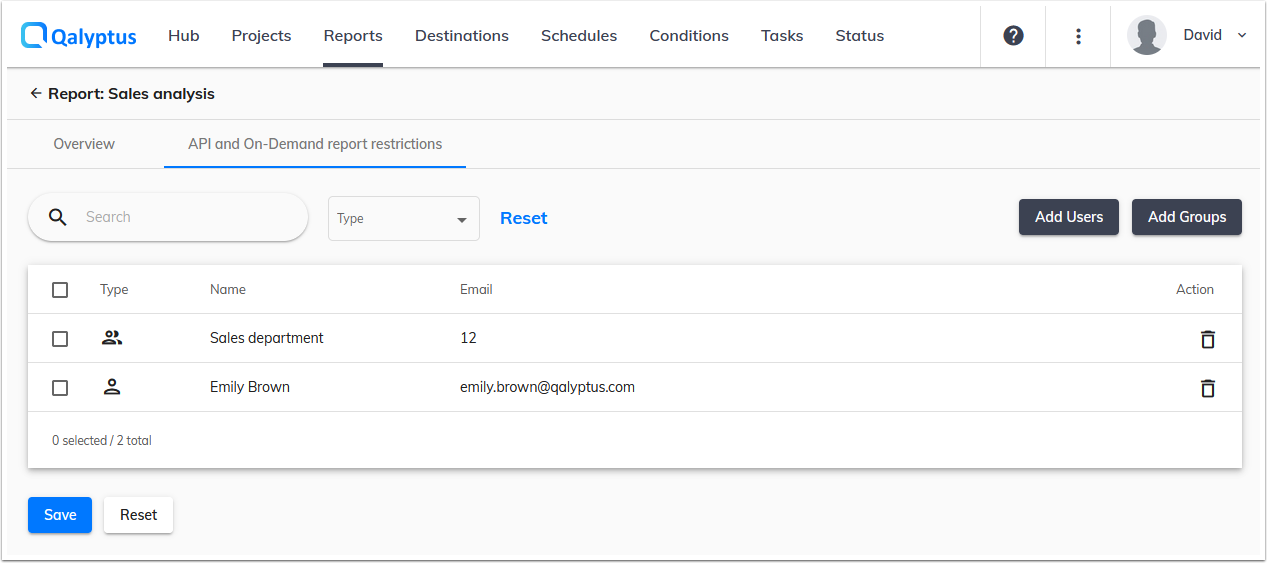
2- Import Qalyptus On-Demand in Qlik Sense QMC
To use the extension Qalyptus On-Demand in Qlik Sense, you need to import it in the Qlik Sense QMC. Qalyptus On-Demand is a zip file that you can find in the machine where Qalyptus Server is installed at this location: “C:\ProgramData\Qalyptus\Extensions” or in your Qalyptus account on the Download page.
To import Qalyptus On-Demand in the QMC, do the following:
- Connect to the Qlik Sense QMC as administrator
- Go to the page Extensions
- Click Import
- Browse to the Qalyptus On-Demand zip file
- Click Import
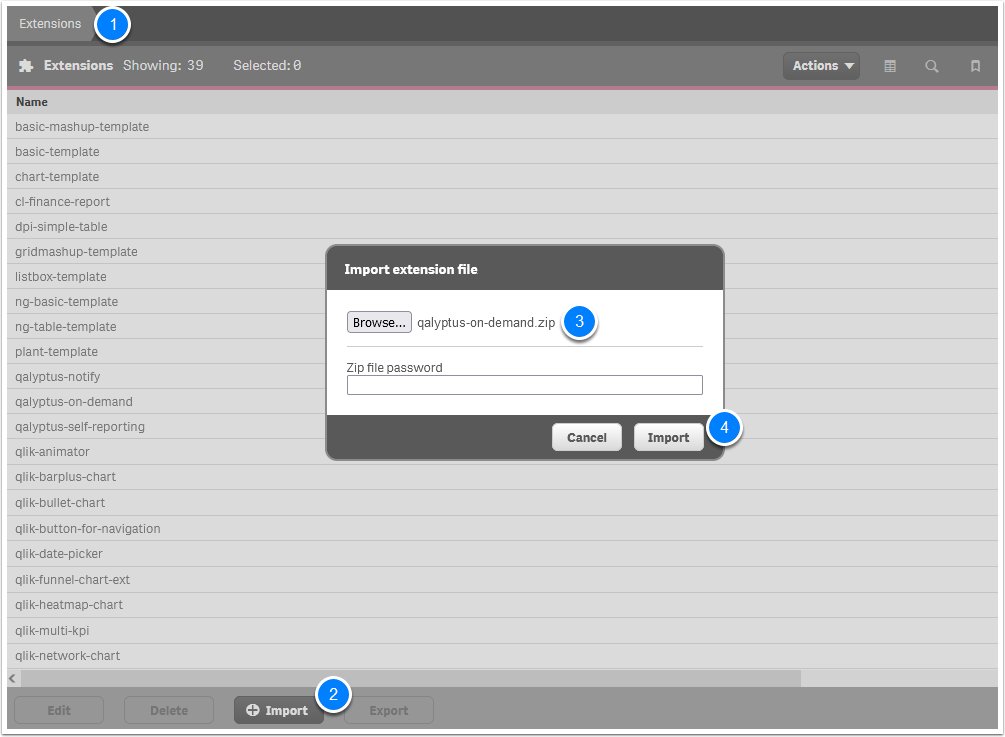
Now Qalyptus On-Demand is ready to be used in Qlik Sense sheets.
3- Add Qalyptus On-Demand to a Qlik Sense sheet
To use Qalyptus On-Demand, you must add it to a Qlik Sense sheet. Qalyptus On-Demand appears in a sheet as a button.
To add Qalyptus On-Demand to a sheet, do the following:
- Open a Qlik Sense sheet for which you have edit rights
- Click Edit sheet, top right
- In the left area, go to Custom objects> Qalyptus bundle
- Drag-and-drop Qalyptus On-Demand
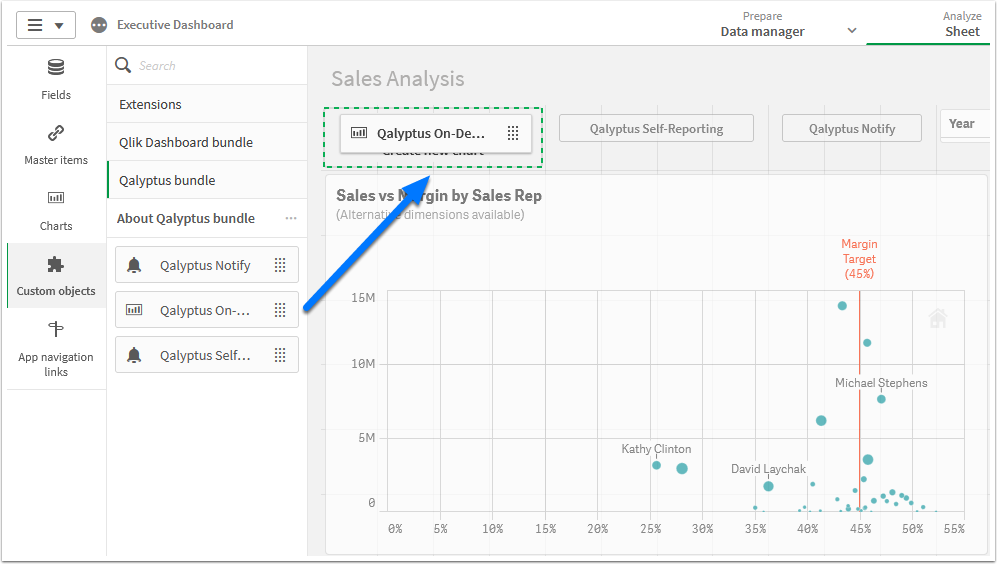
Now we need to configure Qalyptus On-demand to communicate with Qalyptus Server.
In the edit mode of the Qlik Sense sheet, select the Qalyptus On-Demand button to start the configuration.
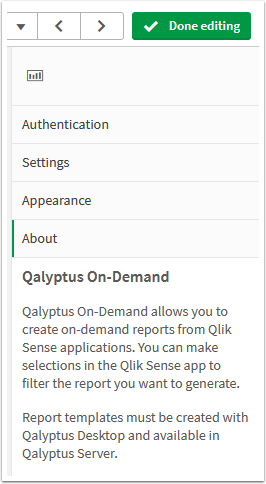
Authentication section
- Add your Qalyptyus Server address. Enter an address as a text or use a Qlik Sense expression that starts with the equal symbol (=). Example : https://qalyptus-server-url.com:3994 or ='https://' & MaxString([my field])
- Choose the authentication method from the available methods:
- Windows authentication (Windows username and password of the user): available with Qalyptus Server Enterprise
- Qalyptus credentials (email and password of a user created in Qalyptus Server): available with Qalyptus Server Business and Qalyptus Server Enterprise
- SSO with SAML (a user authenticate using a Configured Identity Provider): available with Qalyptus Server Enterprise
- JWT (authenticate a user with a JWT token. You must configure a JWT Identity Provider in Qalyptus Server): available with Qalyptus Server Enterprise
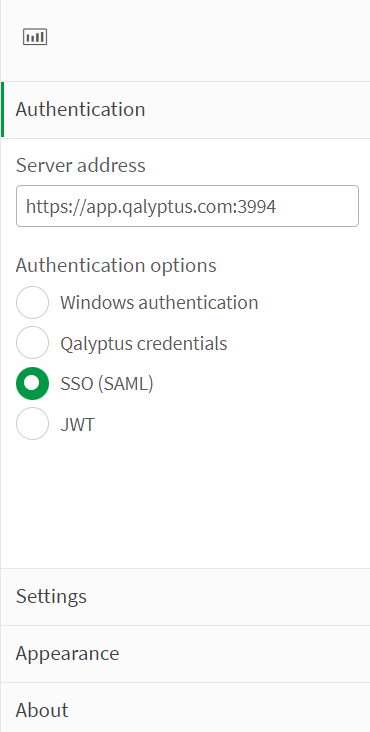
Settings section
This section has three options.
1- Ignore existing report filters: If you check this option, if a user runs a report that contains a filter, Qalyptus will not apply the filter defined in the report. Qalyptus will only apply the current selections if there is. If the option is not checked and the user makes selections, Qalyptus will add the Selections as filters to the existing report filters. Because the order of the filters is important, the selections will be added after the existing report filters.
2- Override report app with current app: For the current selections to be taken into account when generating a report, the report must be created with a Qlik Sense app whose ID is the same as the ID of the current app. Check this option if you want Qalyptus to replace the application ID used in the reports with the current app ID. Use this option only if the current application contains the same objects as the application used to create the report.
-
Examples:
Example 1: You created a report using the app1 (ID=xxx) published in stream S1. This same app exists in stream S2 with an ID=yyy, and you want to generate a report with the current selections from the app with ID=yyy.
Example 2: You created a report using app1 (ID=xxx); you want to generate a report with the current selections from an app generate with ODAG (On-Demand App Generation) method. The new app generated with ODAG will have a different ID.
3- Show only app reports: A user could filter to see only the reports created with the current app. Using this option, you can force to show only the reports or that are created using the current Qlik Sense app. This will hide the filter for the user.

Appearance section
In this section, you can customize the Qalyptus On-Demand button label and the button design.
4- Use Qalyptus On-Demand
Authentication
In the Qlik Sense sheet, click the button Qalyptus On-Demand. The first time, the user must authenticate with the authentication method chosen.
1- Windows authentication, the user must enter his Windows credentials: username in this format DOMAIN\username and his Windows password.
2- Qalyptus credentials, the user must exist in Qalyptus Server and create a password. The user must use his email and the created password. If the user exists in Qalyptus Server and has not yet created a password, he can generate a password on the login page of the Qalyptus Server by clicking the link Forgotten password?
3- SSO with SAML, if you have configured one Identity Provider in Qalyptus Server, the user will be automatically redirected to the Identity Provider Login page. If you have configured more than one Identity Provider, the user will see a Login button for each Identity Provider.
4- JWT, when you choose this option, you can enter the certificate private key (created with the public key used in the Identity provider confoguration) to allow Qalyptus On-Demand generate the jwt token for authentication.
Otherwise, you can use any programming language to sign a jwt token and use the Qalyptus API to authenticate the user. Learn more in Configure a JWT Identity Provider in Qalyptus Server
When you receive the token and refreshToken from Qalyptus Server, store them in the browser's local storage. The user is now authenticated!
Generate a report
After authentication, the user will see the list of reports to which he is entitled.
To generate a report, choose a report in the report list, click Run now, and choose the output format.
Follow the execution status in the Status tab. At the end of the execution, you can download the report, delete the execution entry or run the report again.
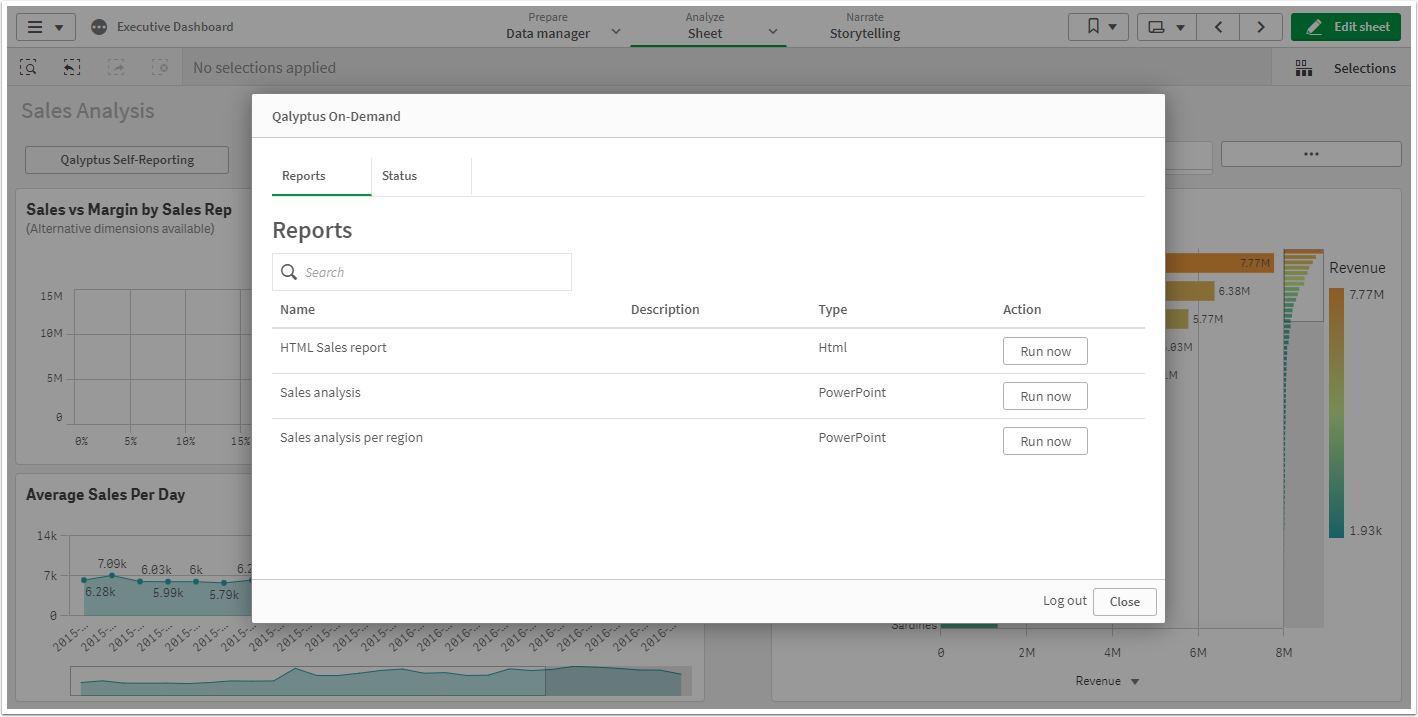
When a user runs a report, Qalyptus will consider the current selections to filter the report data. The selections are considered only if the report uses the current Qlik Sense app (same app ID).
Qalyptus administrators can manage the report executions in Qalyptus Server. If the execution failed, you could access the log file to learn more about the error.
To access the execution status in Qalyptus Server, go to the Status page> On-Demand requests.
